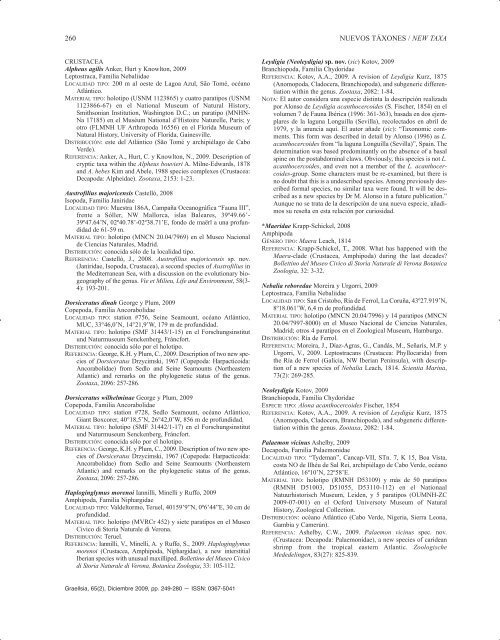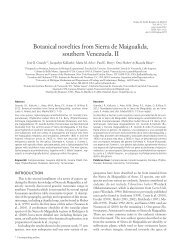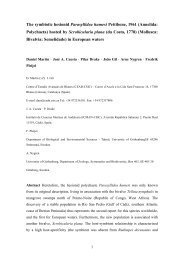Nuevos táxones animales descritos en la península Ibérica y - Csic
Nuevos táxones animales descritos en la península Ibérica y - Csic
Nuevos táxones animales descritos en la península Ibérica y - Csic
You also want an ePaper? Increase the reach of your titles
YUMPU automatically turns print PDFs into web optimized ePapers that Google loves.
260 NUEVOS TÁXONES / NEW TAXA<br />
CRUSTACEA<br />
Alpheus agilis Anker, Hurt y Knowlton, 2009<br />
Leptostraca, Familia Nebaliidae<br />
LOCALIDAD TIPO: 200 m al oeste de Lagoa Azul, São Tomé, océano<br />
Atlántico.<br />
MATERIAL TIPO: holotipo (USNM 1123865) y cuatro paratipos (USNM<br />
1123866-67) <strong>en</strong> el National Museum of Natural History,<br />
Smithsonian Institution, Washington D.C.; un paratipo (MNHN-<br />
Na 17185) <strong>en</strong> el Muséum National d’Histoire Naturelle, París; y<br />
otro (FLMNH UF Arthropoda 16556) <strong>en</strong> el Florida Museum of<br />
Natural History, University of Florida, Gainesville.<br />
DISTRIBUCIÓN: este del Atlántico (São Tomé y archipié<strong>la</strong>go de Cabo<br />
Verde).<br />
REFERENCIA: Anker, A., Hurt, C. y Knowlton, N., 2009. Description of<br />
cryptic taxa within the Alpheus bouvieri A. Milne-Edwards, 1878<br />
and A. hebes Kim and Abele, 1988 species complexes (Crustacea:<br />
Decapoda: Alpheidae). Zootaxa, 2153: 1-23.<br />
Austrofilius majoric<strong>en</strong>sis Castelló, 2008<br />
Isopoda, Familia Janiridae<br />
LOCALIDAD TIPO: Muestra 186A, Campaña Oceanográfica “Fauna III”,<br />
fr<strong>en</strong>te a Sóller, NW Mallorca, is<strong>la</strong>s Baleares, 39º49.66’-<br />
39º47.64’N, 02º40.78’-02º38.71’E, fondo de maërl a una profundidad<br />
de 61-59 m.<br />
MATERIAL TIPO: holotipo (MNCN 20.04/7969) <strong>en</strong> el Museo Nacional<br />
de Ci<strong>en</strong>cias Naturales, Madrid.<br />
DISTRIBUCIÓN: conocida sólo de <strong>la</strong> localidad tipo.<br />
REFERENCIA: Castelló, J., 2008. Austrofilius majoric<strong>en</strong>sis sp. nov.<br />
(Janiridae, Isopoda, Crustacea), a second species of Austrofilius in<br />
the Mediterranean Sea, with a discussion on the evolutionary biogeography<br />
of the g<strong>en</strong>us. Vie et Milieu, Life and Environm<strong>en</strong>t, 58(3-<br />
4): 193-201.<br />
Dorsiceratus dinah George y Plum, 2009<br />
Copepoda, Familia Ancorabolidae<br />
LOCALIDAD TIPO: station #756, Seine Seamount, océano Atlántico,<br />
MUC, 33°46,0’N, 14°21,9’W, 179 m de profundidad.<br />
MATERIAL TIPO: holotipo (SMF 31443/1-15) <strong>en</strong> el Forschungsinstitut<br />
und Naturmuseum S<strong>en</strong>ck<strong>en</strong>berg, Fráncfort.<br />
DISTRIBUCIÓN: conocida sólo por el holotipo.<br />
REFERENCIA: George, K.H. y Plum, C., 2009. Description of two new species<br />
of Dorsiceratus Drzycimski, 1967 (Copepoda: Harpacticoida:<br />
Ancorabolidae) from Sedlo and Seine Seamounts (Northeastern<br />
At<strong>la</strong>ntic) and remarks on the phylog<strong>en</strong>etic status of the g<strong>en</strong>us.<br />
Zootaxa, 2096: 257-286.<br />
Dorsiceratus wilhelminae George y Plum, 2009<br />
Copepoda, Familia Ancorabolidae<br />
LOCALIDAD TIPO: station #728, Sedlo Seamount, océano Atlántico,<br />
Giant Boxcorer, 40°18,5’N, 26°42,0’W, 856 m de profundidad.<br />
MATERIAL TIPO: holotipo (SMF 31442/1-17) <strong>en</strong> el Forschungsinstitut<br />
und Naturmuseum S<strong>en</strong>ck<strong>en</strong>berg, Fráncfort.<br />
DISTRIBUCIÓN: conocida sólo por el holotipo.<br />
REFERENCIA: George, K.H. y Plum, C., 2009. Description of two new species<br />
of Dorsiceratus Drzycimski, 1967 (Copepoda: Harpacticoida:<br />
Ancorabolidae) from Sedlo and Seine Seamounts (Northeastern<br />
At<strong>la</strong>ntic) and remarks on the phylog<strong>en</strong>etic status of the g<strong>en</strong>us.<br />
Zootaxa, 2096: 257-286.<br />
Haploginglymus mor<strong>en</strong>oi Iannilli, Minelli y Ruffo, 2009<br />
Amphipoda, Familia Niphargidae<br />
LOCALIDAD TIPO: Valdeltormo, Teruel, 40159’9”N, 0º6’44”E, 30 cm de<br />
profundidad.<br />
MATERIAL TIPO: holotipo (MVRCr 452) y siete paratipos <strong>en</strong> el Museo<br />
Civico di Storia Naturale di Verona.<br />
DISTRIBUCIÓN: Teruel.<br />
REFERENCIA: Iannilli, V., Minelli, A. y Ruffo, S., 2009. Haploginglymus<br />
mor<strong>en</strong>oi (Crustacea, Amphipoda, Niphargidae), a new interstitial<br />
Iberian species with unusual maxilliped. Bollettino del Museo Civico<br />
di Storia Naturale di Verona, Botanica Zoologia, 33: 105-112.<br />
Graellsia, 65(2), Diciembre 2009, pp. 249-280 — ISSN: 0367-5041<br />
Leydigia (Neoleydigia) sp. nov. (sic) Kotov, 2009<br />
Branchiopoda, Familia Chydoridae<br />
REFERENCIA: Kotov, A.A., 2009. A revision of Leydigia Kurz, 1875<br />
(Anomopoda, C<strong>la</strong>docera, Branchiopoda), and subg<strong>en</strong>eric differ<strong>en</strong>tiation<br />
within the g<strong>en</strong>us. Zootaxa, 2082: 1-84.<br />
NOTA: El autor considera una especie distinta <strong>la</strong> descripción realizada<br />
por Alonso de Leydigia acanthocercoides (S. Fischer, 1854) <strong>en</strong> el<br />
volum<strong>en</strong> 7 de Fauna <strong>Ibérica</strong> (1996: 361-363), basada <strong>en</strong> dos ejemp<strong>la</strong>res<br />
de <strong>la</strong> <strong>la</strong>guna Longuil<strong>la</strong> (Sevil<strong>la</strong>), recolectados <strong>en</strong> abril de<br />
1979, y <strong>la</strong> anuncia aquí. El autor añade (sic): “Taxonomic comm<strong>en</strong>ts.<br />
This form was described in detail by Alonso (1996) as L.<br />
acanthocercoides from “<strong>la</strong> <strong>la</strong>guna Longuil<strong>la</strong> (Sevil<strong>la</strong>)”, Spain. The<br />
determination was based predominantly on the abs<strong>en</strong>ce of a basal<br />
spine on the postabdominal c<strong>la</strong>ws. Obviously, this species is not L.<br />
acanthocercoides, and ev<strong>en</strong> not a member of the L. acanthocercoides-group.<br />
Some characters must be re-examined, but there is<br />
no doubt that this is a undescribed species. Among previously described<br />
formal species, no simi<strong>la</strong>r taxa were found. It will be described<br />
as a new species by Dr M. Alonso in a future publication.”<br />
Aunque no se trata de <strong>la</strong> descripción de una nueva especie, añadimos<br />
su reseña <strong>en</strong> esta re<strong>la</strong>ción por curiosidad.<br />
*Maeridae Krapp-Schickel, 2008<br />
Amphipoda<br />
GÉNERO TIPO: Maera Leach, 1814<br />
REFERENCIA: Krapp-Schickel, T., 2008. What has happ<strong>en</strong>ed with the<br />
Maera-c<strong>la</strong>de (Crustacea, Amphipoda) during the <strong>la</strong>st decades?<br />
Bollettino del Museo Civico di Storia Naturale di Verona Botanica<br />
Zoologia, 32: 3-32.<br />
Nebalia reboredae Moreira y Urgorri, 2009<br />
Leptostraca, Familia Nebaliidae<br />
LOCALIDAD TIPO: San Cristobo, Ría de Ferrol, La Coruña, 43º27.919’N,<br />
8º18.061’W, 6,4 m de profundidad.<br />
MATERIAL TIPO: holotipo (MNCN 20.04/7996) y 14 paratipos (MNCN<br />
20.04/7997-8000) <strong>en</strong> el Museo Nacional de Ci<strong>en</strong>cias Naturales,<br />
Madrid; otros 4 paratipos <strong>en</strong> el Zoological Museum, Hamburgo.<br />
DISTRIBUCIÓN: Ría de Ferrol.<br />
REFERENCIA: Moreira, J., Díaz-Agras, G., Candás, M., Señarís, M.P. y<br />
Urgorri, V., 2009. Leptostracans (Crustacea: Phyllocarida) from<br />
the Ría de Ferrol (Galicia, NW Iberian P<strong>en</strong>insu<strong>la</strong>), with description<br />
of a new species of Nebalia Leach, 1814. Sci<strong>en</strong>tia Marina,<br />
73(2): 269-285.<br />
Neoleydigia Kotov, 2009<br />
Branchiopoda, Familia Chydoridae<br />
ESPECIE TIPO: Alona acanthocercoides Fischer, 1854<br />
REFERENCIA: Kotov, A.A., 2009. A revision of Leydigia Kurz, 1875<br />
(Anomopoda, C<strong>la</strong>docera, Branchiopoda), and subg<strong>en</strong>eric differ<strong>en</strong>tiation<br />
within the g<strong>en</strong>us. Zootaxa, 2082: 1-84.<br />
Pa<strong>la</strong>emon vicinus Ashelby, 2009<br />
Decapoda, Familia Pa<strong>la</strong>emonidae<br />
LOCALIDAD TIPO: “Tydeman”, Cancap-VII, STn. 7, K 15, Boa Vista,<br />
costa NO de Ilhéu de Sal Rei, archipié<strong>la</strong>go de Cabo Verde, océano<br />
Atlántico, 16º10’N, 22º58’E.<br />
MATERIAL TIPO: holotipo (RMNH D53109) y más de 50 paratipos<br />
(RMNH D51003, D51055, D53110-112) <strong>en</strong> el Nationaal<br />
Natuurhistorisch Museum, Leid<strong>en</strong>, y 5 paratipos (OUMNH-ZC<br />
2009-07-001) <strong>en</strong> el Ocford Universoty Museum of Natural<br />
History, Zoological Collection.<br />
DISTRIBUCIÓN: océano Atlántico (Cabo Verde, Nigeria, Sierra Leona,<br />
Gambia y Camerún).<br />
REFERENCIA: Ashelby, C.W., 2009. Pa<strong>la</strong>emon vicinus spec. nov.<br />
(Crustacea: Decapoda: Pa<strong>la</strong>emonidae), a new species of caridean<br />
shrimp from the tropical eastern At<strong>la</strong>ntic. Zoologische<br />
Mededeling<strong>en</strong>, 83(27): 825-839.

















